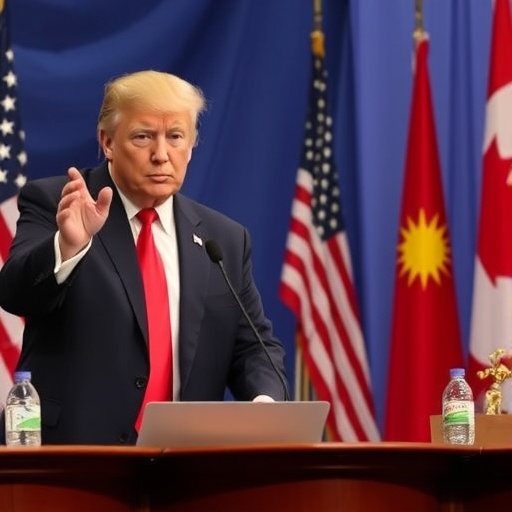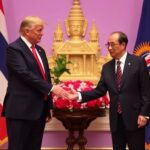Trump‘s Tariffs Eclipse ASEAN Summit: New Levies on Canada Spark Global Trade War Fears
In a dramatic escalation of President Donald Trump‘s trade agenda, fresh tariffs on Canadian imports have overshadowed the ongoing ASEAN summit, sending shockwaves through international alliances and igniting fears of a broader trade war. Announced just hours before key discussions kicked off in Singapore, the 25 percent duties on Canadian steel and aluminum underscore Trump‘s unyielding stance on protecting American industries, even at the expense of longstanding partners. As leaders from the Association of Southeast Asian Nations (ASEAN) convene, the specter of these tariffs looms large, complicating talks on regional economic integration and forcing allies to recalibrate their strategies amid rising tensions with China.
The move against Canada, a key U.S. ally and member of the North American Free Trade Agreement (NAFTA), marks a pivotal moment in Trump’s tariff-heavy approach. With bilateral trade between the U.S. and Canada exceeding $600 billion annually, economists warn that these measures could disrupt supply chains from automotive manufacturing to energy exports. “This is not just about steel; it’s a signal to the world that America First means business,” Trump declared in a White House briefing, emphasizing his administration’s resolve to address perceived trade imbalances.
New Tariffs Slam Canadian Economy, Testing NAFTA Bonds
The announcement of tariffs on Canada has hit like a thunderbolt at the ASEAN summit, where trade ministers from 10 Southeast Asian nations were already navigating delicate balances between U.S. and Chinese influences. Targeting $16 billion worth of Canadian steel and aluminum exports, the duties—effective immediately—represent a 25 percent hike on steel and 10 percent on aluminum, echoing similar actions Trump took earlier against global suppliers. Canadian Prime Minister Justin Trudeau responded swiftly, calling the decision “deeply disappointing” and vowing retaliatory measures that could include tariffs on U.S. agricultural goods and whiskey.
According to data from the U.S. International Trade Commission, Canada supplies over 16 percent of America’s steel imports and nearly 60 percent of its aluminum, making the tariffs a direct blow to industries reliant on cross-border flows. In 2017 alone, U.S.-Canada trade in metals totaled $12.5 billion, supporting thousands of jobs on both sides of the border. Experts like Dr. Elena Vasquez, a trade policy analyst at the Brookings Institution, highlight the ripple effects: “These tariffs don’t just hurt Canada; they inflate costs for American manufacturers, potentially adding $1,000 to the price of a new car.”
At the summit, Canadian delegates, though not formal ASEAN members, have been vocal in side meetings, urging Southeast Asian leaders to present a united front against unilateral trade actions. The tariffs come at a precarious time for NAFTA renegotiations, with talks stalled over dairy market access and auto rules of origin. Trudeau’s office released a statement emphasizing, “Canada stands ready to defend its workers and will not be bullied into unfair concessions.” This escalation risks fracturing the trilateral pact, which underpins North American economic stability.
- Key Impacts on Canada: Immediate job losses in Alberta’s aluminum sector, estimated at 5,000 positions.
- U.S. Repercussions: Higher raw material costs could slow GDP growth by 0.2 percent in Q3, per Federal Reserve projections.
- Global Precedent: Signals potential for similar duties on ASEAN exports like electronics and textiles.
ASEAN Summit Hijacked by Trump’s Trade War Shadow
Originally slated to focus on digital economy frameworks and sustainable development, the 33rd ASEAN Summit has been derailed by the thunderous rollout of Trump’s tariffs. Hosted in Singapore from November 13-15, the gathering brings together heads of state from Indonesia, Thailand, Vietnam, and others, alongside dialogue partners like the U.S. and China. But with Trump’s trade war dominating headlines, discussions have pivoted to safeguarding regional supply chains from U.S. protectionism.
ASEAN’s combined GDP of $2.8 trillion makes it a vital player in global trade, with intra-regional commerce reaching $600 billion last year. Yet, the bloc’s heavy reliance on exports to the U.S.—Vietnam alone ships $40 billion in goods annually—leaves it vulnerable. Singapore’s Prime Minister Lee Hsien Loong, in his opening remarks, cautioned, “Unilateral tariffs undermine the multilateral trading system we all depend on. ASEAN must adapt without retreating into isolation.”
Behind closed doors, ASEAN nations are weighing options: some, like Malaysia, advocate for deeper ties with China via the Regional Comprehensive Economic Partnership (RCEP), while others, such as the Philippines, seek U.S. reassurances. A leaked summit document reveals concerns over “tariff contagion,” where duties on Canada could prelude actions against Asian steel producers. Statistics from the World Trade Organization (WTO) show that U.S. tariffs since 2018 have already reduced global trade growth by 0.5 percent, a trend ASEAN leaders are desperate to reverse.
Trump’s virtual address to the summit, pre-recorded due to scheduling conflicts, reiterated his “fair trade” mantra: “America has been taken advantage of for decades. These tariffs level the playing field.” Critics, including ASEAN Secretary-General Lim Jock Hoi, argue that such moves violate WTO rules, potentially inviting disputes that could drag on for years.
Anticipated Trump-Xi Showdown Fuels China Trade War Anxieties
As the ASEAN summit unfolds, all eyes are on the anticipated high-stakes dialogue between President Trump and Chinese President Xi Jinping, set for the sidelines in a bid to thaw frosty relations. Trump’s trade war with China, which began in 2018 with tariffs on $300 billion in goods, has already cost both economies dearly—U.S. farmers lost $27 billion in exports, while Chinese manufacturers faced 25 percent duties on key sectors like tech and machinery.
The U.S.-China trade deficit stood at $419 billion in 2018, a figure Trump has repeatedly cited as justification for his aggressive posture. Yet, recent data from the U.S. Census Bureau indicates a slight narrowing to $345 billion in 2022, thanks to diversified sourcing from ASEAN countries. At the summit, Xi is expected to push for tariff rollbacks in exchange for concessions on intellectual property theft and market access, issues that have plagued bilateral ties.
“This meeting could be a turning point or a breaking point,” says Jonathan Hill, director of the Asia Society Policy Institute. “Trump’s leverage is strong with these new Canadian tariffs as a backdrop, but Xi won’t yield without reciprocity.” Protests outside the summit venue in Singapore highlight public sentiment, with banners reading “End the Trade War Now.” Chinese state media has framed the talks as an opportunity for “win-win cooperation,” contrasting Trump’s combative rhetoric.
Stakeholders in ASEAN are caught in the crossfire. Indonesia, a major nickel exporter, fears collateral damage from U.S.-China escalations, while Thailand’s auto industry—tied to both markets—braces for volatility. A recent PwC report estimates that a prolonged trade war could shave 1.5 percent off ASEAN’s annual growth, underscoring the summit’s urgency.
- Past Escalations: 2018 tariffs led to China’s retaliation on U.S. soybeans, costing $12 billion.
- Current Stakes: Phase One deal from 2020 remains fragile, with only 58 percent of purchase commitments met.
- Future Outlook: Successful talks could unlock $200 billion in new trade opportunities.
Economic Fallout Ripples Through Asia-Pacific Alliances
The tariffs on Canada are not occurring in isolation; they amplify existing fractures in Asia-Pacific trade dynamics, where ASEAN nations juggle U.S. security guarantees with Chinese economic heft. Japan’s Prime Minister Fumio Kishida, attending as a dialogue partner, expressed solidarity with Canada, stating, “Protectionism threatens the prosperity we’ve built together.” Bilateral trade between Japan and the U.S. hit $300 billion last year, but rising tariffs could deter investments in shared sectors like semiconductors.
In Vietnam, which has boomed as a China trade war beneficiary—exports to the U.S. surged 40 percent since 2018—business leaders are wary. The Vietnam Chamber of Commerce reports that 70 percent of firms fear retaliatory tariffs if the U.S. views the shift as circumvention. Meanwhile, Australia’s iron ore exports, vital to Chinese steel production, could face indirect hits if Trump expands duties.
Quantitative analysis from the IMF projects that full-blown trade wars could reduce global GDP by 0.8 percent by 2025, with ASEAN bearing a disproportionate 1.2 percent loss. Quotes from summit participants paint a picture of unease: Indonesian Trade Minister Agus Suparmanto warned, “We cannot afford a world divided by tariffs; cooperation is our only path.” Environmental advocates also chime in, noting that disrupted supply chains could hinder green tech transfers essential for ASEAN’s net-zero goals.
The human element is stark: In Canada’s Ontario steel mills, workers like 45-year-old machinist Tom Reilly told reporters, “These tariffs mean layoffs for families like mine who’ve relied on this trade for generations.” Similar anxieties echo in ASEAN factories, where U.S. demand drives 20 percent of manufacturing output.
Path Forward: Navigating Tariff Turbulence Toward Stable Trade
As the ASEAN summit progresses, the path ahead hinges on diplomatic maneuvering to mitigate Trump’s tariff onslaught. Leaders are pushing for an ASEAN-U.S. free trade framework to counterbalance bilateral frictions, with proposals for reduced duties on regional goods like palm oil and apparel. The European Union, observing from afar, has signaled readiness to host mediation talks post-summit, potentially involving WTO arbitration.
Looking ahead, the Trump-Xi meeting could yield a temporary truce, perhaps extending the Phase One agreement with new agricultural purchases from China to offset Canadian losses. Economists forecast that de-escalation might boost global trade volumes by 2 percent in 2024. For Canada, emergency aid packages totaling CAD 2 billion are in discussion to cushion the blow, while U.S. businesses lobby Congress for exemptions.
Ultimately, the summit’s legacy may lie in fostering resilience: ASEAN’s push for RCEP ratification, covering 30 percent of global GDP, offers a buffer against U.S.-centric trade wars. As one delegate put it, “Tariffs may divide, but unity will endure.” With stakes this high, the world watches whether dialogue prevails over division in reshaping international commerce.









